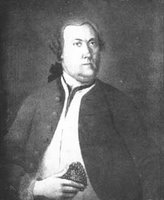Contest Winner!
 Dawn P. won the second horticulture technology trivia contest by submitting the correct answers on Friday 16th. Kudos to Don. S. who also got the correct answer just a few hours after Dawn.
Dawn P. won the second horticulture technology trivia contest by submitting the correct answers on Friday 16th. Kudos to Don. S. who also got the correct answer just a few hours after Dawn.There will be a new contest question posted this Thursday afternoon (in order to give more students a chance to look at it before the weekend.)
About Pehr Kalm, for whom the genus Kalmia was named (courtesy wikipedia.org)
Pehr Kalm (March 6, 1716 - November 16, 1779) (in Finland also known as Pietari Kalm and in some English-language translations as Peter Kalm) was a Finnish explorer, botanist, naturalist, and agricultural economist. He was one of Carolus Linnaeus's most important students. Among his many accomplishments, Kalm can be credited with the first written description of the Niagara Falls, and the first comprehensive study of North American natural history.
Kalm was born in Ångermanland, Sweden, where his parents had taken refuge during the Great Northern War. When the hostilities were over, the family returned home to Närpes in Ostrobothnia, Finland, where Kalm's father was a Lutheran minister. Kalm studied at the Academy of Åbo from 1735, and from 1740 at the University of Uppsala, where he met the renowned naturalist Carolus Linnaeus and became one of his first students. In Uppsala Kalm became the superintendent of an experimental plantation.
Kalm did field research in Sweden, Russia and Ukraine from 1742 to 1746, when he was appointed Docent of Natural History and Economics at the Åbo Academy. In 1747 he the Academy elevated him to Professor of Economics, and the same year he was also appointed by Linneaus and the Royal Swedish Academy of Sciences to travel to North America, to find seeds and plants that might prove useful for agriculture or industry. In particular, they wanted him to bring back the red mulberry, Morus rubra, in the hope of starting a silk industry in Finland (which then was an integral part of Sweden).
Kalm arrived in Pennsylvania in 1748, and made the Swedish-Finnish expatriate communities in southern New Jersey his base of operations . There he served as the pastor of a local church, and there he married in 1750. He made trips as far west as Niagara Falls and as far north as Quebec, before returning in 1751. After his return he established a botanical garden in Turku/Åbo, where he also taught at the Åbo Academy until his death in 1771.
Kalm's journal of his travels was published as En Resa til Norra America (Stockholm, 1753–1761). It was translated into English in 1770 as Travels into North America. In his Species Plantarum, Linnaeus cites Kalm for 90 species, 60 of them new.

0 Comments:
Post a Comment
<< Home